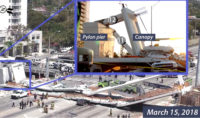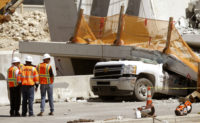Attorneys for families of the six people who were killed and for survivors of 2018’s Florida International University pedestrian bridge collapse say Louis Berger Group is the last defendant that has not yet agreed to settle lawsuits in state court in Miami. The legal actions target companies that designed and built the bridge.
Berger’s work on the project raises several sticky questions about the relationship between peer review quality and the liability such reviews create. Berger’s peer review included only final design and not intermediate phases during construction, according to an investigative report by the U.S. Occupational Safety & Health Administration published in June. The structure collapsed before important final connections had been completed.
Had Berger checked construction conditions, the tragedy could have been averted, OSHA claimed.
Florida Dept. of Transportation peer-review rules ask that the work be done by a separate firm and include “constructability” and “compatibility of construction phasing with Traffic Control.” The rules do not include the words “interim phases of construction” or “construction loads.” But language in the state plans manual seems to imply that the review should be extensive.
Insurers for Munilla Construction Management (MCM)—now Magnum Construction Management—agreed in late April to contribute $42 million to a settlement fund. Separately, FIGG Bridge Engineers, the project’s Tallahassee-based main designer, has also agreed to contribute to the settlement fund, as have more than 20 subcontractors, the Miami Herald reported.
To date, Berger Group has declined to comment on its role or on OSHA’s report, which spread criticism among FIGG Bridge Engineers, MCM, inspection contractor Bolton, Perez and state transportation officials.
OSHA was especially pointed in its criticism of FIGG, the engineer-of-record on the project, which has declined to admit to errors or respond directly to the criticism that its design lacked redundancy and that the company failed to act when alarming cracks appeared on the structure. FIGG has indicated that it would await the completion of the National Transportation Safety Board’s investigation before commenting further.
OSHA’s report stated that Berger declined to turn over its emails with FIGG Bridge Engineers.
Stuart Grossman, an attorney representing Richard Humble, who was an SUV passenger beneath the bridge and was injured when it collapsed, said the reasons for not conducting a more complete peer review of the unusual structure remain unknown. “If they felt there was a need for further inspections, they certainly never spoke up,” he says. “As a result, it gave everybody a false sense of safety.”
Whether Berger should have known what was stated in the OSHA report, that Florida state rules require peer review of all phases of the project, isn’t clear. Nevertheless, OSHA investigators wrote, “If Louis Berger had checked the design at Stage 3, it could have discovered structural deficiencies in the design and this incident could have been prevented.” Both Berger and FIGG failed to comply with the intent and meaning of FDOT’s rules, the agency’s report added.
Unlike physicians, who enjoy legal immunity for most peer reviews under state laws, U.S. engineers have no similar privilege, except in Missouri and Kansas. The National Society of Professional Engineers has supported immunity, and in a position statement adopted in 2017 said that both pre-and post-project reviews should include language “shielding reviews from being used as lawsuit evidence, and provide that anyone who attempts to inappropriately acquire” the protected information will be responsible for the peer reviewer’s legal fees.
Without immunity, it’s wise for engineers to be careful in describing the work they will perform in the review, says attorney Kenneth E. Rubinstein. “You could say load calculations all appear to be accurate but you could also say you have not examined the underlying foundations and assume it will be poured to the appropriate depth. What is standard is to call that out, to say outright that the underlying work was never verified.”
In a lawsuit, using the excuse that all the phases of construction were never verified would be a weak defense, says Rubinstein, who is a director in the Boston and Concord, N.H., offices of Preti, Flaherty. “And saying that the fee was small [as Berger Group’s peer review engineer told OSHA] would work against you,” he adds.
The Berger structural engineer who conducted the peer review told OSHA investigators that four months after the completion of the peer review, he was no longer working at the company for reasons unrelated to the project.
By Richard Korman with Scott Judy







Post a comment to this article
Report Abusive Comment